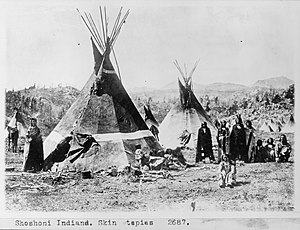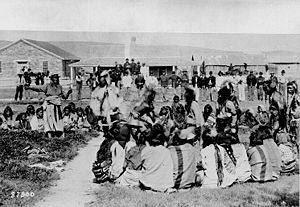Shoshone
This article needs additional citations for verification. (April 2007) |


The Shoshone ( or ) are a Native American tribe with three large divisions: the Northern, the Western and the Eastern.
The Northern Shoshone are concentrated in eastern Idaho, western Wyoming, and north-eastern Utah. The Eastern lived in Wyoming, northern Colorado and Montana. Conflict with the Blackfoot, Crow, Lakota, Cheyennes, and Arapahos pushed them south and westward after about 1750. The Western ranged from central Idaho, northwestern Utah, central Nevada, and in California about Death Valley and Panamint Valley. This group is sometimes called the Panamint. The Idaho groups of Western Shoshone were called Tukuaduka (sheep eaters), while the Nevada/Utah ones were called the Gosiute or Toi Ticutta (cattail eaters).
Possibly the most famous member of the Shoshone tribe was Sacajawea who accompanied the Corps of Discovery with Meriwether Lewis and William Clark in their exploration of the Western United States. The estimated population of Northern and Western Shoshone was 4,500 in 1845. 3,650 Northern Shoshone and 1,201 Western Shoshone were counted in 1937 by the United States Bureau of Indian Affairs.
History
The Northern Shoshone fought conflicts with settlers in Idaho in the 1860s which included the Bear River Massacre and again in 1878 in the Bannock War. They fought alongside the United States Army in the 1876 Battle of the Rosebud against their traditional enemies, the Lakota and Cheyenne.
In 1911 a small group of Bannock under a leader named "Shoshone Mike" killed four ranchers in Washoe County, Nevada[1]. A posse was formed, and on February 26, 1911, they caught up with the band, and eight of them were killed, along with one member of the posse, Ed Hogle[2]. Three children and a woman who survived the battle were captured. The remains of some of the members of the band were repatriated from the Smithsonian Institution to the Fort Hall Idaho Shoshone-Bannock Tribe in 1994[3].
In 1982, the Western Shoshone, who also invited "unrepresented tribes," made a declaration of sovereignty and began issuing its own passports as the Western Shoshone National Council.
In 2008, the Shoshone Nation acquired the site of the Bear River Massacre[4].
Reservations

- Wind River Reservation, population 2,650 Eastern Shoshone, 2,268,008 acres (9,178 km²) of reservation in Wyoming are shared with the Northern Arapaho
- Fort Hall Indian Reservation, 544,000 acres (2,201 km²) in Idaho, Lemhi and Northern Shoshone with the Bannock Indians, a Paiute band with which they have merged
- Lemhi Indian Reservation (1875–1907) in Idaho, Lemhi Shoshoni, removed to Fort Hall Reservation
- Duck Valley Indian Reservation, southern Idaho/northern Nevada, Western Shoshone
- Ely Shoshone Indian Reservation in Ely, Nevada, 111 acres (0.45 km²), 500 members
- Fallon Paiute-Shoshone Reservation near Fallon, Nevada, 8,200 acres (33 km²), 991 members, Western Shoshone and Paiute
- Goshute Indian Reservation, 111,000 acres (449 km²) in Nevada and Utah, Western Shoshone
- Skull Valley Indian Reservation, 18,000 acres (73 km²) in Utah, Western Shoshone
- Fort McDermitt Indian Reservation, Nevada and Oregon, Fort McDermitt Paiute and Shoshone Tribe
- Reno-Sparks Indian Colony, Nevada, 1988 acres (8 km²), total 481 member of Shoshone, Paiute, and Washoe bands
- Duckwater Indian Reservation, located in Duckwater, Nevada, approximately 75 miles (121 km) from Ely.
- Nevada Shoshone Indian Reservation, near Carson City, Nevada, 211 members
References
See also
External links
- Northern Shoshoni treaties
- Ely Shoshone Reservation
- Goshute Indian Reservation
- Great Basin Indian Archives
- Reno-Sparks Indian Colony
- Te-Moak Tribe of the Western Shoshone Indians of Nevada
- Timbisha Tribe of the Western Shoshone Nation
- U.S. Treaty with the Western Shoshone 1863, Ruby Valley
- Western Shoshone Defense Project
